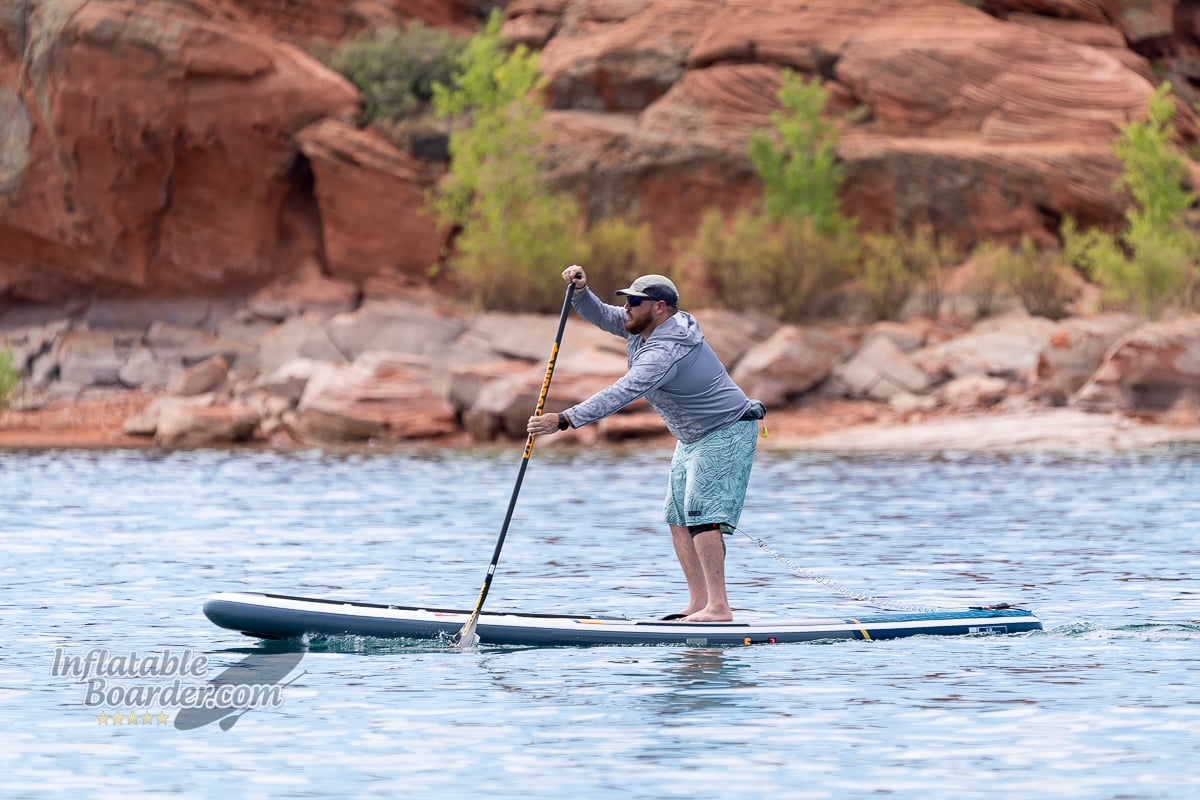
The Red Paddle Co 12’6” Elite blurs the lines between touring, fitness and racing.
Red Paddle Co. 12’6” Elite: Overview
The Red Paddle Co. 12’6” Elite iSUP blends user-friendly stability, unique technology, and a shape designed for efficiency to create a paddleboard that can be used for touring, fitness, and even racing. If you are an intermediate or advanced paddler looking to chase podiums, gains, or a sunset, the 12’6” Elite is ready for you. Beginner paddlers may struggle with the relatively narrow width compared to a more traditional touring or fitness board like the Red Paddle Co. Voyager or Sport and should carefully consider the difference in learning curve required for a high-efficiency paddleboard like the Red 12’6” Elite.
— Red Paddle Co 12’6” Elite Summary Ratings and Review —
Red Paddle Co 12’6” Elite
-
Construction & Durability
-
Features and Versatility
-
Stability
-
Speed
-
Maneuverability
-
Tracking
Overall Score
The Red Paddle Co. 12’6” Elite blurs the lines between touring and racing iSUP. It uses high-quality construction and unique technological solutions to improve performance.
Pros
- MSL construction for increased stiffness, decreased weight, and excellent durability
- Fiberglass RSS Battens on the side of the board increase stiffness around the standing area while still allowing the board to be highly portable.
- Carbon fiber Front Flex Control rod keeps the front half of the board stiff and stable when paddling in choppy conditions
- D-rings and a threaded accessory mounting point expand the board’s versatility.
- The parallel standing area, high-quality embossed deck pad, and raised rail structures provide excellent stability and control
- 25 PSI maximum inflation pressure creates a very stiff board.
- High quality fiberglass fin, bag, and excellent Titan II pump all included.
Cons
- The FFC rod and associated anchor points add weight to the front of the board, so users need to stabilize the board while carrying it to prevent dropping the nose onto the ground.
- The raised rail pads and kick pad could be larger for even better control
Construction and Durability
Red Paddle Co. is well known within the stand up paddleboard industry as making some of the highest-quality inflatable boards in the market. Their commitment to detail is second to none. The MSL process used in the 12’6” Elite reduces weight and increases stiffness. The welded rails add durability. And the pièce de résistance are the fiberglass RSS battens and carbon fiber FCC rod to increase stiffness in the standing area and reduce board flex in choppy conditions. These out-of-the-box (out-of-the-board?) features are unique to Red Paddle Co. and have performance and durability at their core.
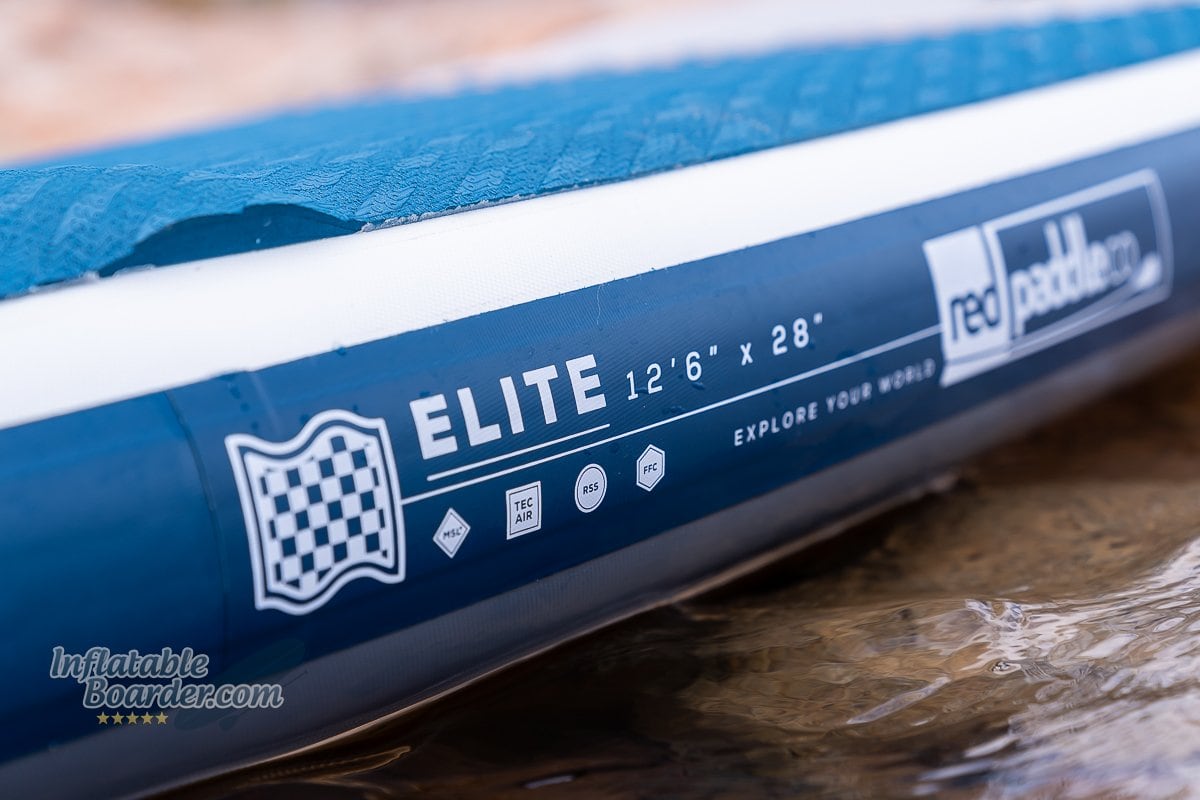
The Red Paddle Co 12’6” Elite uses MSL construction, welded seams, and several exterior stiffening elements.
The Red Paddle Co 12’6” and 14’ Elite iSUPs are some of Red’s most advanced iSUPs to date.
The Elite starts with a 5.9” thick drop stitch core made with woven fabric and cross-woven space yarns, for a lighter and stiffer core compared to the knitted fabrics and linear drop stitch used in the majority of the industry. As part of the MSL (Monocoque Structural Laminate) process, the fabric layer is coated with an adhesive before a reinforced layer of PVC is machine laminated onto the core. This produces an extremely stiff, durable, and light base for the Elite and Red’s other MSL products. The seams are then glued and heat sealed with two PVC rail layers to complete the core construction.
In addition to the MSL construction, the 12’6” Elite also uses Red’s second generation Rocker Stiffening System (RSS) battens. These fiberglass battens are inserted into specially designed slots in the rail on either side of the standing area to improve the overall stiffness of the board.
In addition to the RSS Battens, Red Paddle Co. also created a new FFC (Front Flex Control) rod system that uses a two-piece carbon fiber rod and hard anchor points to reduce flex in the front half of the board.
These two external stiffening systems do add a fair amount of complexity and weight to the front half of the board. While I don’t anticipate any mechanical issues with either of these systems, this does create a lot of parts and pieces that will need additional care and maintenance over the life of the board.
The MSL construction, RSS battens, and FFC rod are all designed to make the Red Elite as stiff as possible. The RSS battens do add some stiffness to the standing area. Red Paddle Co. claims a 40%-50% increase in stiffness with the RSS battens; our bend test showed only a 10% increase in stiffness. However even a 10% increase in stiffness is significant, especially considering the low level of flex in the board even without them.
The FFC rod is not designed to stiffen the standing area of the board, but rather to prevent the nose of the board from flexing in very choppy conditions. While testing the 12’6” Elite I was presented with a fair amount of boat wake, but did not feel any discrete benefit. Our other testers have used the 12’6” Elite in more consistently rough conditions and do feel a benefit with the FFC rod helping the board maintain its shape and more cleanly handling the chop.
It’s difficult to say if these external elements do a better job than built-in counter parts (like additional rail layers and stringers), but they are certainly doing their job.
I did notice during testing that the 12’6” Elite was not the stiffest board on the water for me. I felt some flex in the board and in reviewing the photos can clearly see where the board bends in front of the standing area. One big plus to these stiffening systems is, though, that while the 12’6” Elite did still have some flex, it was spread out more evenly across the board rather than bending directly at my feet. While bouncing on the board, there was a noticeable bend at the standing area (picture below), but while paddling the bend was essentially stretched out into more of a continuous rocker profile (you can see this in the top image of this review). So while the RSS battens and FCC rod didn’t eliminate bend, they changed how it bent.
The 12’6” Elite does not have any built-in stringers that run the length of the board. I feel like this is a very basic stiffening technique that is well implemented in many other boards and should be a consideration to add for future versions of the 12’6” and 14’ Elite iSUPs by Red Paddle Co. These long stringers help stiffen the board further and spread any flex out across the length of the board evenly.
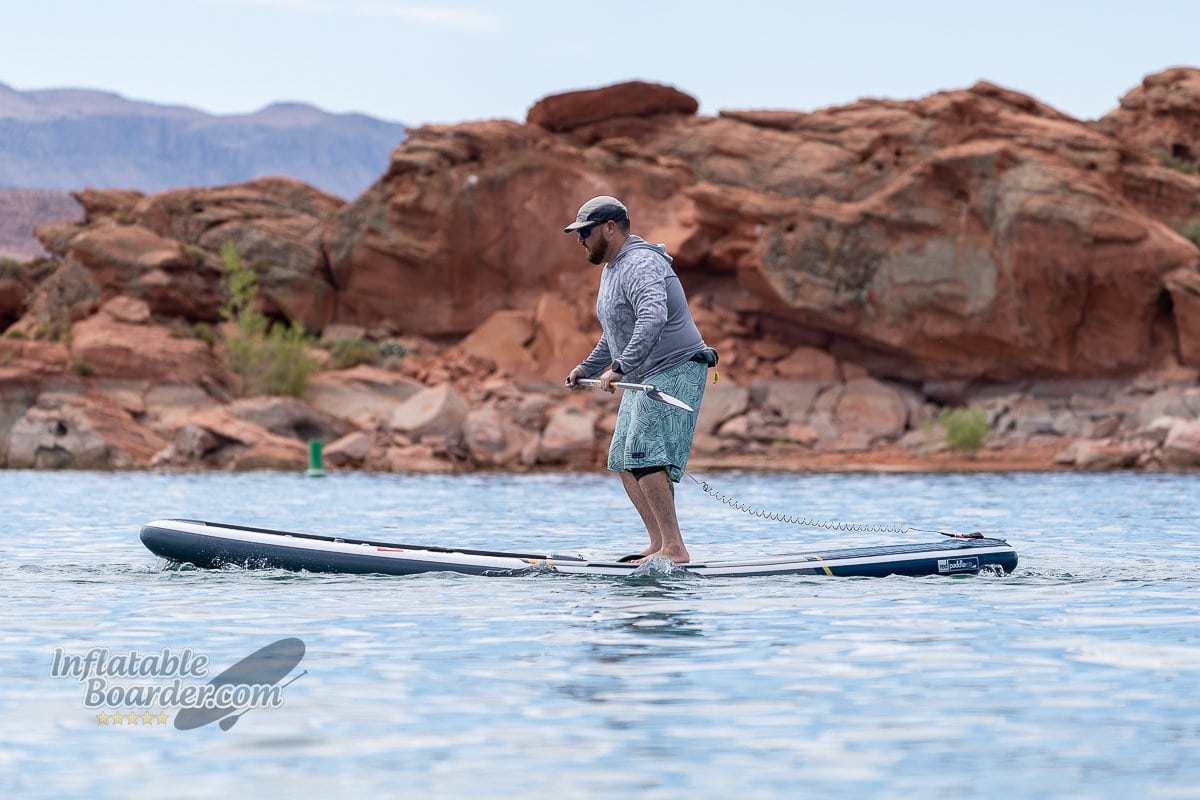
Even with the RSS battens and FFC rod, the Elite still exhibited a fair amount of flex while bouncing, but they did mellow the bend while paddling.
Specifications
| Dimensions | |
| Length | 12’ 6” |
| Width | 28“ |
| Thickness | 5.9“ |
| Weight | |
| Max Capacity | 265 pounds |
| Board Weight | 25 pounds |
| Kit Weight (SUP & accessories) | 35 pounds |
| Buying Info | |
| List Price | $1359.00 |
| Warranty | 3 years |
| Returns period | 30 days |
Features, Accessories and Versatility
The Red Paddle Co 12’6” Elite sits on the line between touring and racing iSUPs. Its design intention is to be a faster, racing board, but it still maintains a significant amount of width at 28” wide. Most racing boards will max out around 26” wide, while most touring boards are closer to 30” wide.
By coming in between these ranges the board opens itself up to a larger audience of intermediate paddlers who want an efficient touring board and may want to get into racing, but don’t want a racing-only SUP. The 12’6” Elite also has d-rings on the front to secure cargo and a threaded accessory mount for a GPS, action camera, or other device.

The Red Paddle Co 12’6” Elite features multiple stiffening systems and raised rail supports for additional stability.

The Red Paddle Co 12’6” Elite is 12’6” long x 28” wide x 5.9” thick.
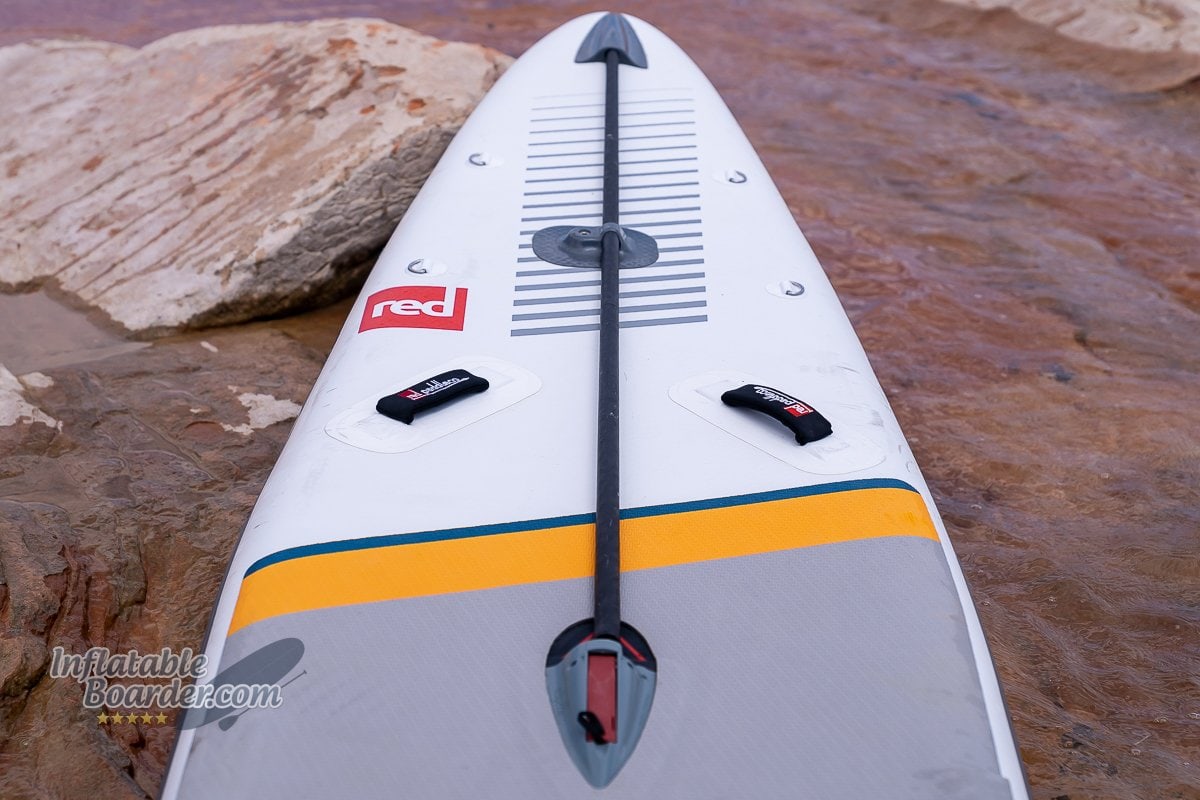
The nose has a four-point bungee tie down system, race handles, FFC rod, and a threaded accessory mount.
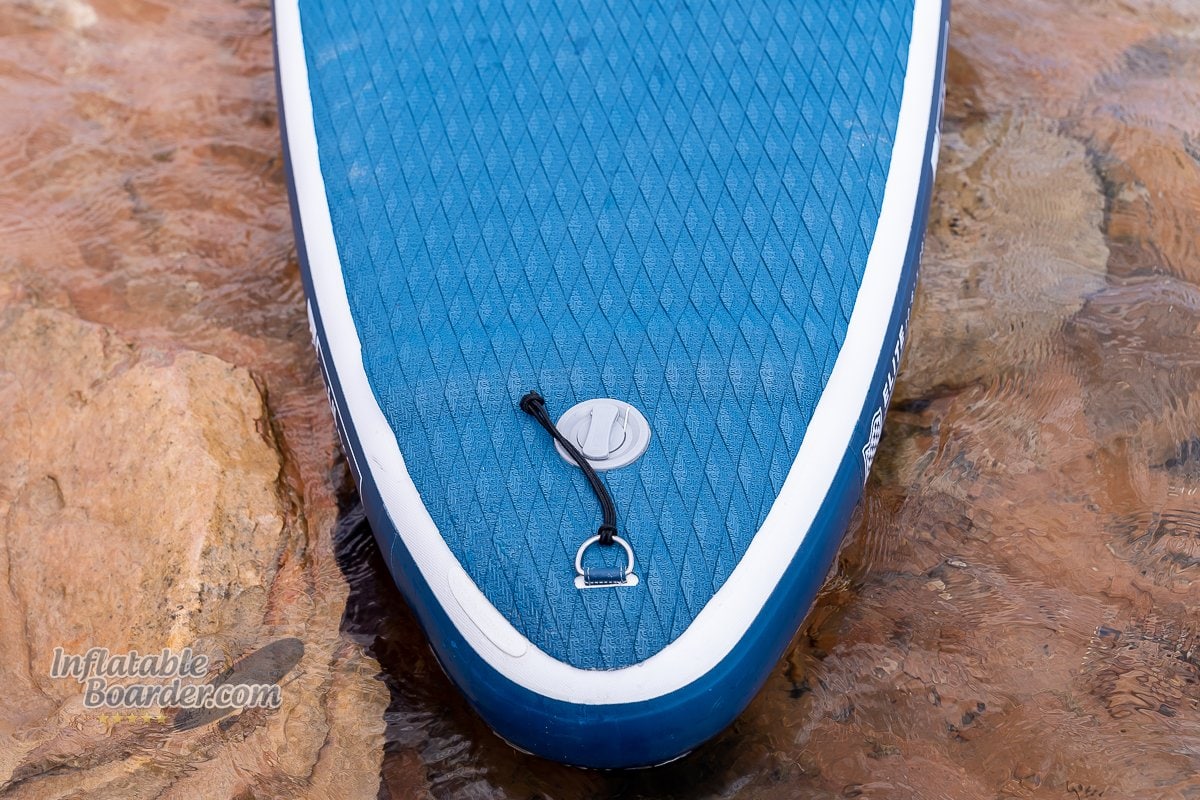
The tail of the board has a full-length diamond groove deck pad and a relatively small, rounded kick pad.
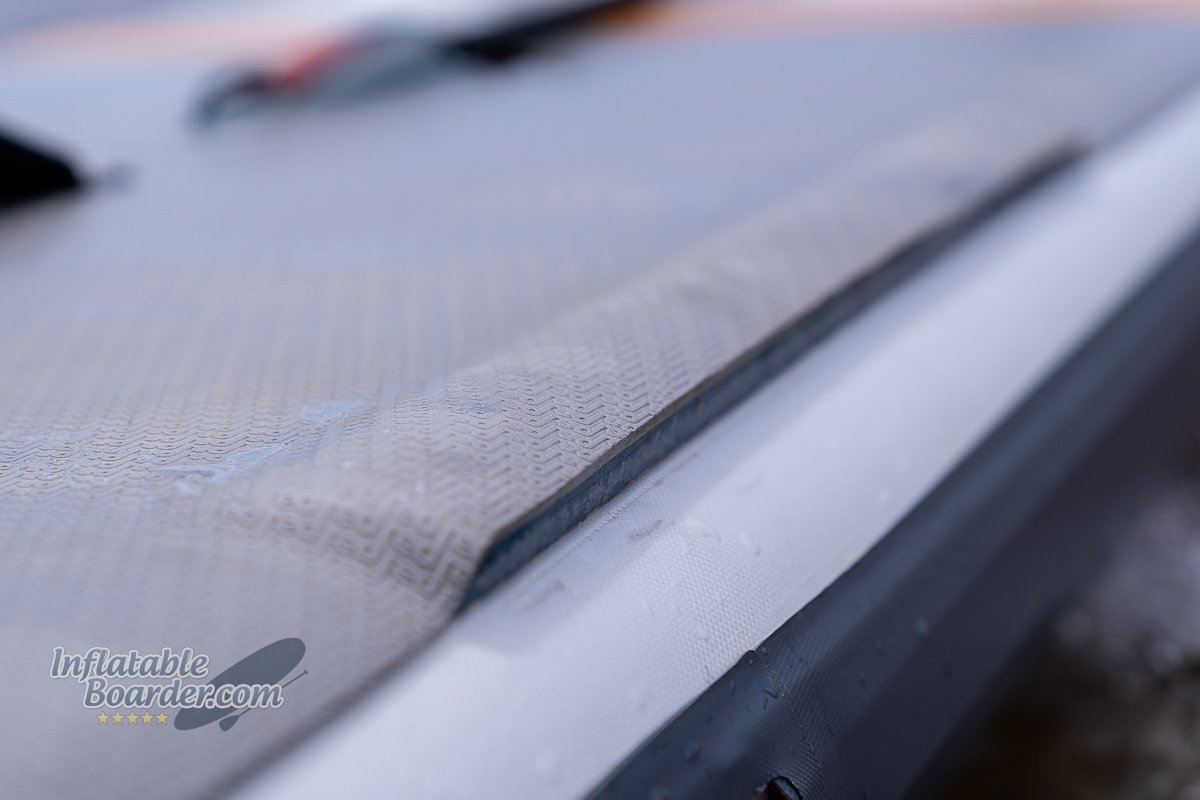
The raised rail supports give paddlers a little more support for better edge control.
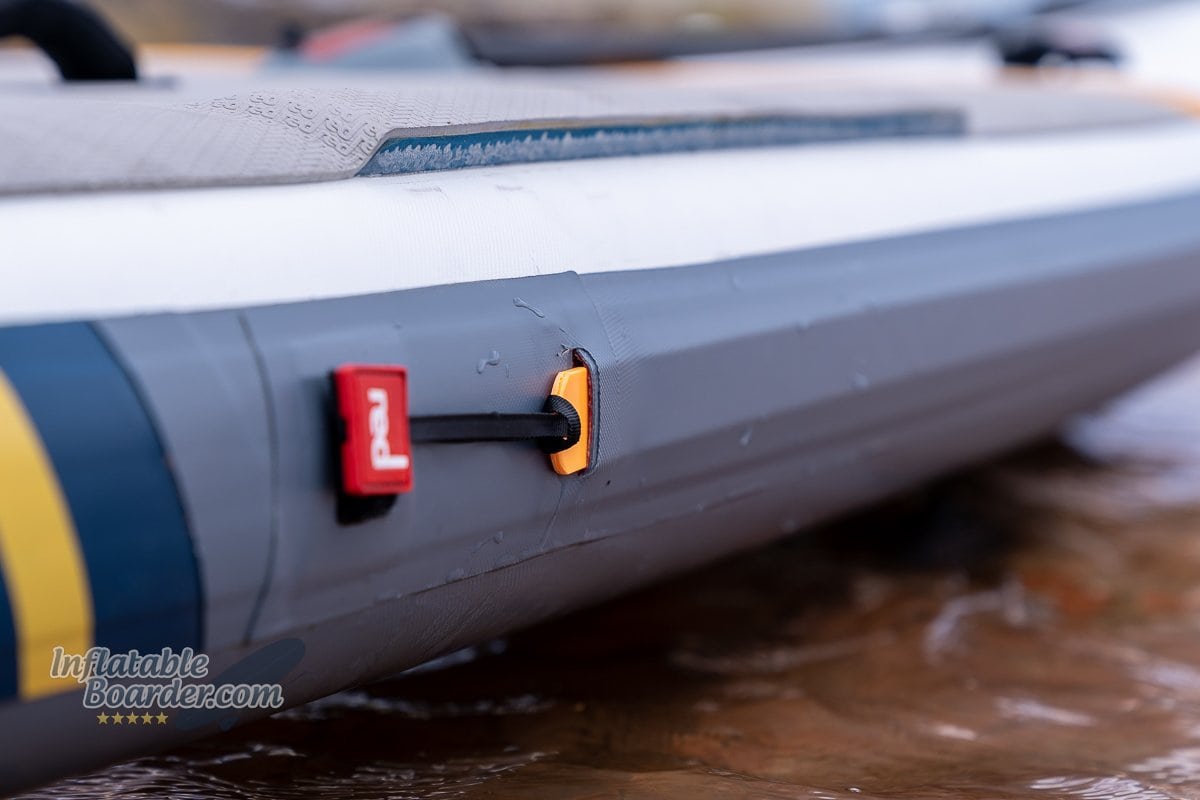
The fiberglass RSS battens are inserted prior to pressurizing the board and help prevent flex around the standing area.
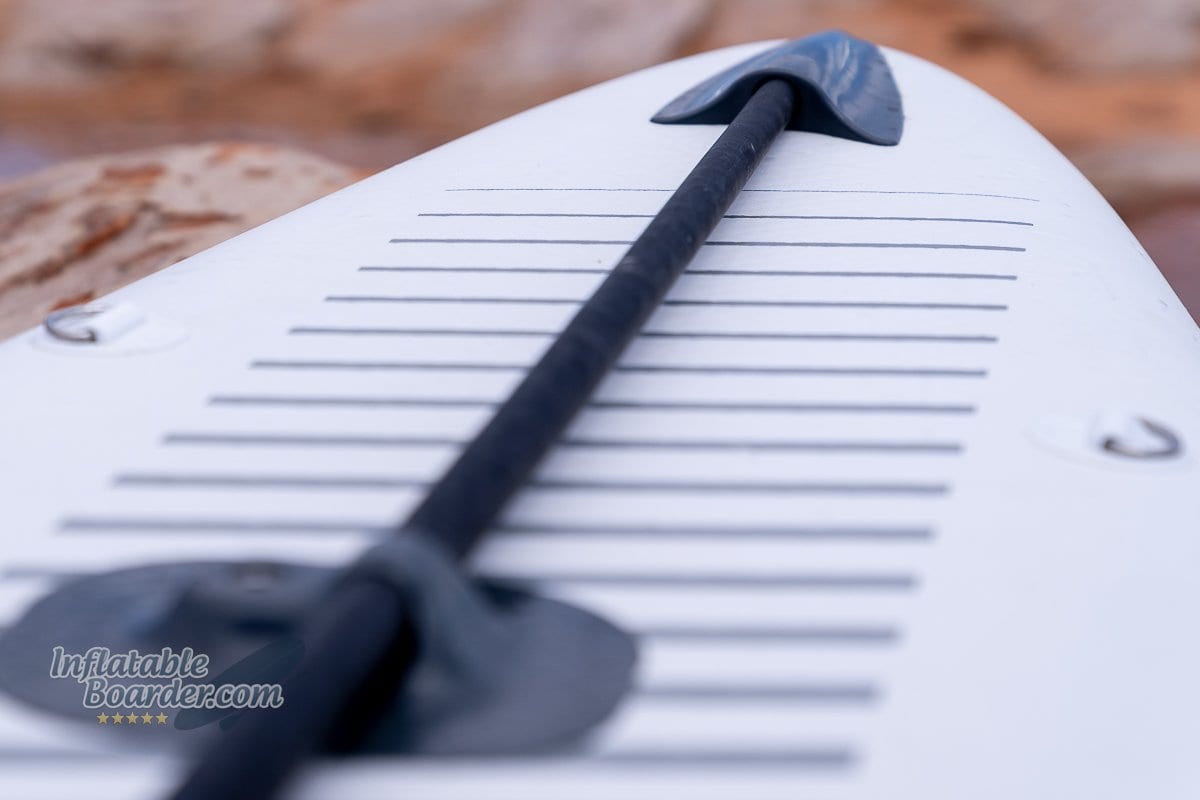
The carbon fiber FFC rod is inserted after the board is inflated and is anchored in three spots to reduce flex in the front of the board.
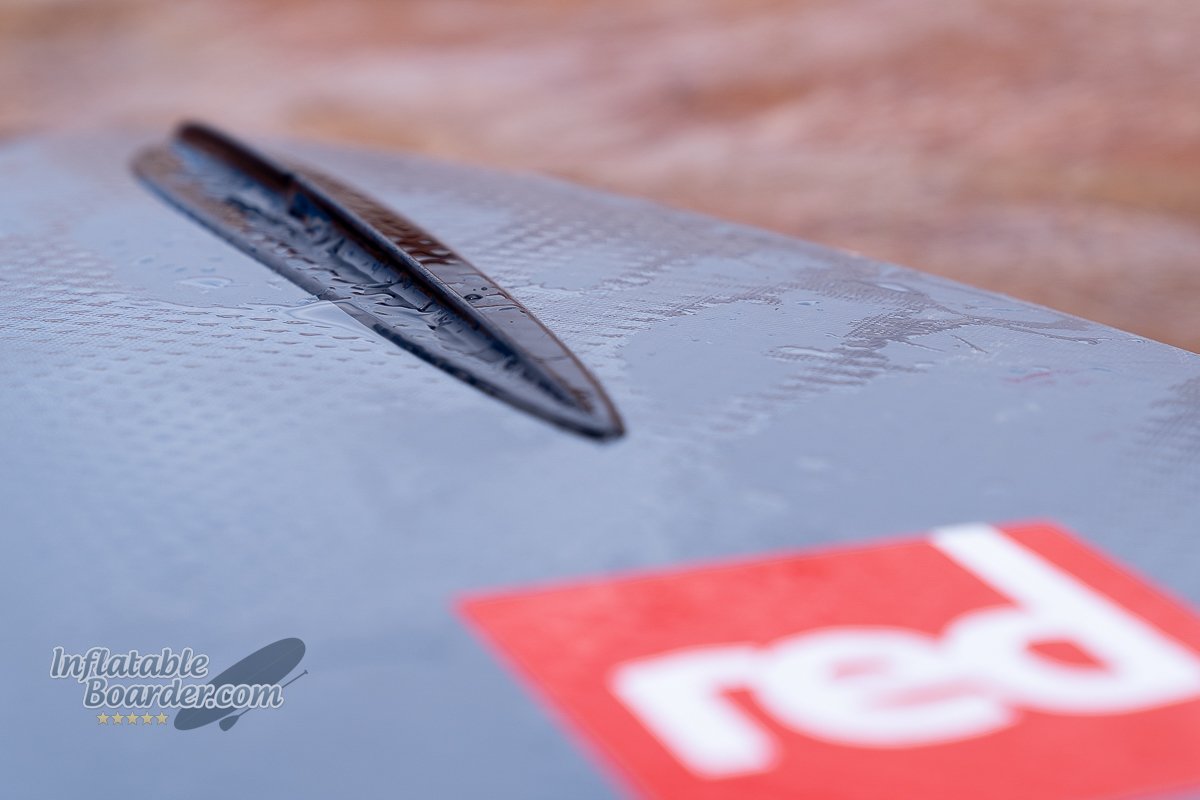
Under the nose is a small plastic “nose runner” to help reduce surface tension as your speed increases.
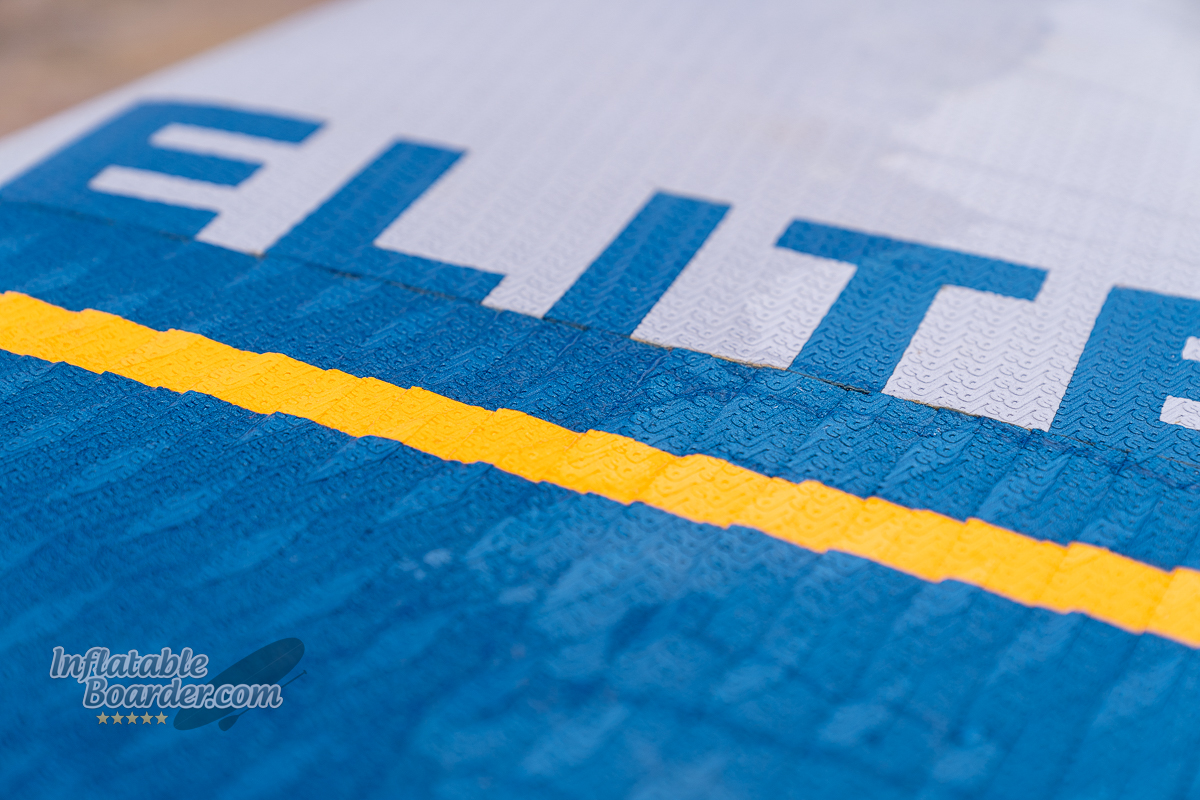
The deck pad is logo embossed and transitions to a logo embossed and diamond groove texture in the rear third of the board.
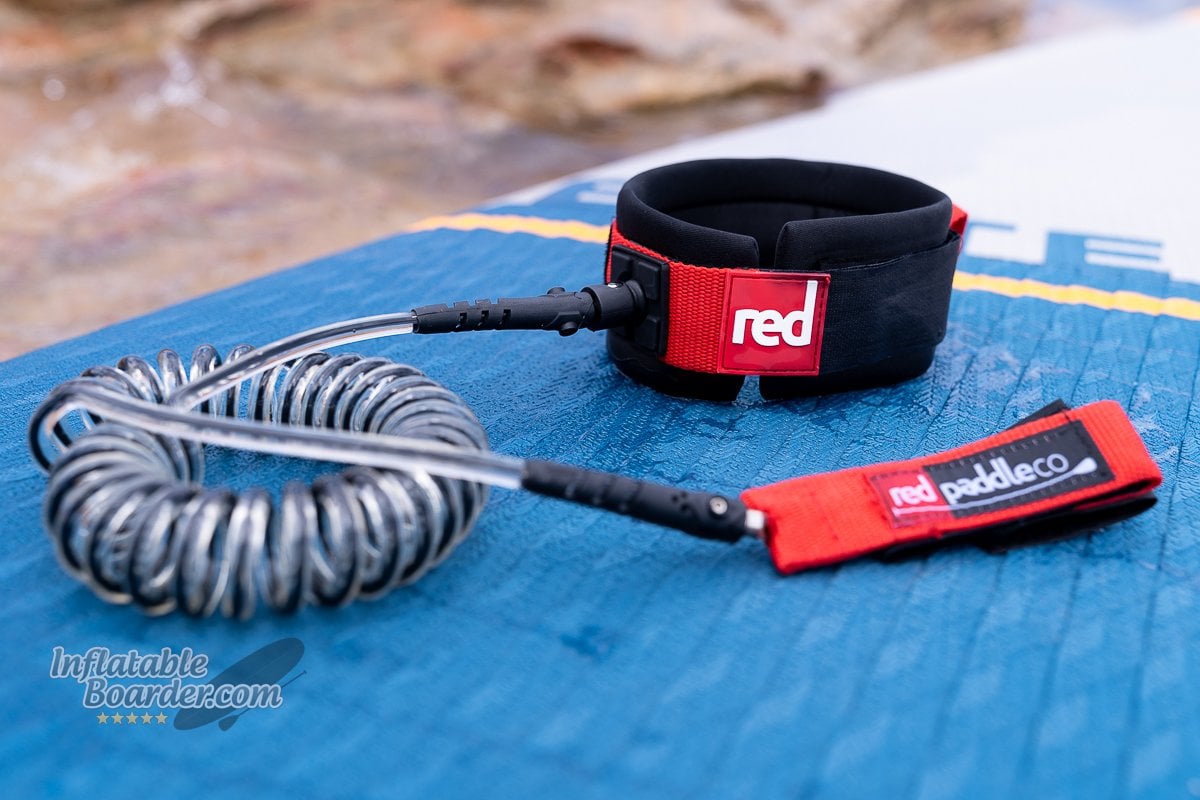
The 12’6” Elite includes a comfortable coiled leash that can be worn around the ankle or the calf.
The extra width in the 12’6” Elite does increase its versatility and expands the appeal to a broader audience, but the board becomes the Jack of All Trades. It is good for racing; it is also good for touring, but it’s not the best at either. Those who want to go faster will want a narrower and lighter board that is easier to accelerate and maintain a higher top speed. Those who want to load up and explore the coast for a few days will want more cargo room and a little more stability. But those who want a little bit of both will be right at home.
In the front of the board, the first thing most people notice is the FFC rod and anchor points. I covered the FFC rod in the Construction section above. The middle anchor point has a threaded accessory mount built into it for a camera, gps unit, or other accessory. There’s also a four-point tiedown system here in the front, though it does not come standard with any bungee cord or other straps. The FFC rod and anchor point do limit how effectively you can carry equipment, though. Because the middle anchor point is permanent, removing the FFC rod to increase storage space doesn’t really add much space.
Closer to the standing area are two race handles. These handles are placed in such a way to help racers balance their board for running beach starts without dipping the nose or dragging the tail. They are also important any time you are carrying the board to help counterbalance the weight from the FFC system.
The 12’6” Elite (and 14’ Elite) has a small raised rail made of EVA foam surrounding the standing area. This raised section is designed to give you more control and grip while engaging the rails of the board. Because the 12’6” Elite is 28” wide, I rarely found myself using these raised pads as I would have to move my feet a little wider than my normal standing position to do so. I also felt they were too small to offer significant improvements in grip over the already high-quality logo-embossed deck pad. Increasing their size another half, or one inch would greatly increase their effectiveness.
Around the sides of the board, the rails have narrow pockets and velcro tabs to accept the Rocker Stiffening System (RSS) battens. I found that the velcro tabs of the battens were frequently loose in the water. However, because the battens are inserted prior to pressurizing the board, they are held in place by the board pressure rather than the velcro, so this was more of a cosmetic annoyance than an actual concern.
The rear third of the board features a diamond groove pattern in the deck pad (in addition to still being embossed) for additional grip when stepping back to the tail. There is a kick pad directly in front of the inflation valve, and like the raised rails, is a little undersized. At first glance you can’t really even see it. You can feel it with your feet as you step back, but it doesn’t offer much surface area to stand on during a pivot turn or to press against while surfing or down-winding.
The underside of the board features a standard US fin box at the tail and a small plastic “fin” at the nose. This nose fin isn’t meant to help with tracking, but rather to reduce surface tension at the point where the board meets the water. Reducing the surface tension, in theory, allows the board to slip through the water more efficiently. However, how much impact this particular element actually makes on glide and speed is unknown. I have a feeling that in computer modeling it’s noticeable, but in real life there are so many other variables at play that it is negligible. Had I paddled this board and another of the same with the nose “fin” removed I highly doubt I would have noticed its absence as things like wind, chop, and the quality of the catch phase of your paddle stroke are likely to make more difference in paddling efficiency.
Overall the Red Paddle Co. 12’6” Elite is a great board for the fitness paddler, day-touring paddler, and intermediate racer. The stiffening systems help control flex, rather than prevent it, but they do limit the way one can use the board for longer touring trips. The 12’6” Elite is still a fast iSUP, it’s still efficient on the water, and is still a great choice for the paddler who wants all of those things, but isn’t looking for a truly dedicated race board.
Stability
I found the stability of the 12’6” Elite to match its sizing very well. Intermediate or advanced paddlers would have no issue adjusting to the 28” width in just a few minutes. Newer paddlers may not feel it is quite wide enough for comfort (but probably stand-able with some effort), and true beginners would not find it to be very stable if they can stand up. The deck pad provides excellent traction throughout the standing area and the raised rails help balance and control the board a little bit, but not quite as much as I had hoped.
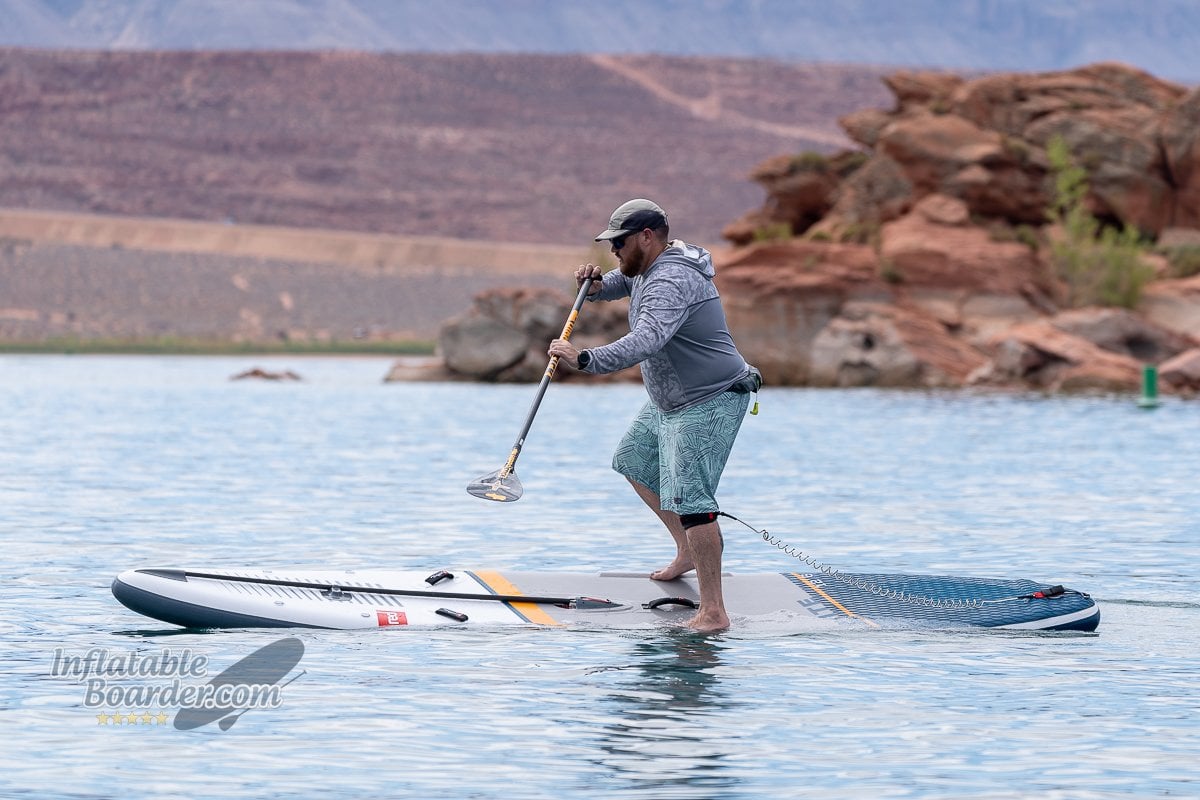
The 12’6” Elite is plenty stable for the intermediate paddler, but isn’t ideal for beginners.
Stability in a paddleboard comes from several different factors. The width of the board is the most obvious one to most, but the length, shape, and thickness all play a role as well.
The overall primary stability (how stable it feels while flat on the water) is exactly where an experienced paddler would expect it to be given the 28” width and other measurements. Balancing does take a little bit of concentration to start with, particularly if you are paddling in choppier conditions, but quickly settles out under a loose lower body. Beginner paddlers would find the 12’6” to be a decent challenge to stand on, and true first-timers should probably seek out something wider for increased stability.
The 12’6” Elite has a bit of an interesting outline. The standing area is quite parallel and boxy, and there are noticeably sharp shoulders and hips where the board begins to taper to the nose and tail. Those shoulders and hips change the profile quite rapidly while the board is balancing on its rail, making it a little more challenging to hold on its edge for steering or balance recovery. The raised rail pads do help a little bit, but only very slightly, and only if you already have your feet on them.
What I find to be interesting is that the 14’ Elite has a slightly different outline with more gradual changes at the shoulders and hips. I have a feeling that even though the 14’ Elite is an inch narrower, the secondary stability (on its rail) would actually be improved over the 12’6” Elite due to the increased volume and surface area in contact with the water.
Lastly, when walking back to the tail of the board the change in stability is fairly predictable. The rounded tail offers less stability when sunk for a pivot turn, but faster turning, better engagement in the face of a wave, and less drag on the surface compared to a wider square tail.
Speed
Even though it may be wider than a dedicated racing SUP, the 12’6” Elite is still a very fast board. It definitely tops the charts for speed over its closest touring board cousins, and gives dedicated racing SUPs a run for their money in the right hands. The 12’6” Elite closes the gap on racing boards even further when paddled over longer distances.
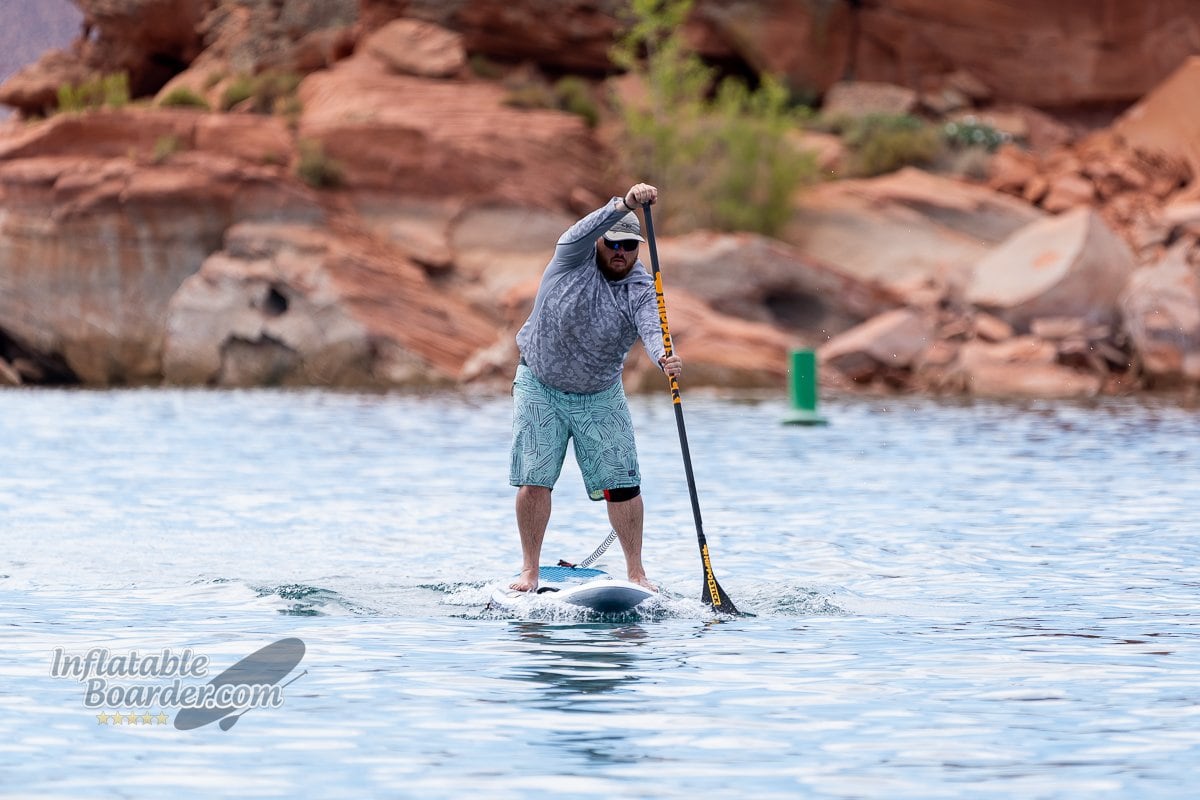
The 12’6” Elite accelerates smoothly and offers an excellent top-end speed for paddlers with high-quality paddle strokes.
We used an NK SpeedCoach SUP2 GPS unit to track and measure our speed during testing. With four very different paddlers, we hit top speeds between 5.1 and 5.9 mph (8.2 – 9.5 kmh) while sprinting. iSUPs that are made specifically for touring tend to top out in the low to mid 5mph range (8 kmh), so there is a noticeable increase in top speed with the 12’6” Elite over touring-specific boards. Compared to racing-specific iSUPs, the 12’6” Elite comes very close to matching those narrower boards, but fell just shy for all of our testers.
Using a cadence that could be maintained for multiple miles at a time, cruising speeds rang in around the 4.5 mph mark (7.2 kmh) for our group. Again, comparing touring specific boards we would normally see cruising speeds in the neighborhood of 4 mph (6.4 kmh), and dedicated racing iSUPs around 4.8 mph (7.73 kmh).
I did notice some flex in the 12’6” Elite during heavy sprinting, but it was minimal. The first time I took it out on the water, I also struggled to find the sweet spot to stand in. The FFC rod’s extra weight, change in the board’s rocker profile, and visual placement (It made the board appear visually shorter to me), took some getting used to, but it did resolve after just a few minutes and a few adjustments.
Maneuverability and Tracking
For both touring and racing, tracking performance is key. It’s so much easier and faster to paddle longer distances when the board remains pointed where you want it to go, even when paddling on one side for extended periods of time. The 12’6” Elite did an excellent job tracking and maintaining a course. At the same time you could easily steer the board to a different direction, but quick turning does require repositioning back on the board for some degree of a pivot turn. This is pretty typical for longer paddleboards, though, and should be expected at this length.
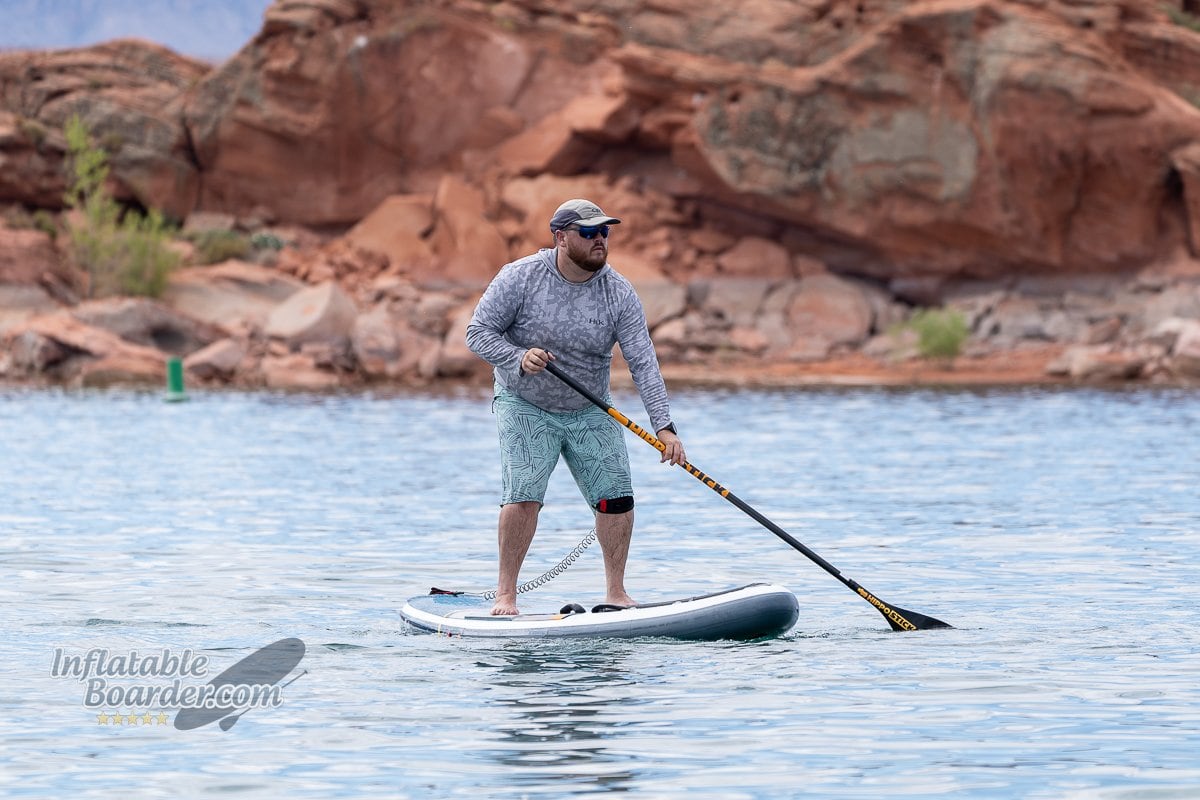
The 12’6” Elite responds well to steering strokes while paddling but tracks well, so it can be a little trickier to turn quickly unless you are stopped or paddling slowly.
Longer paddleboards will always be harder to turn than shorter SUPs. The extra length in the water means more surface area to push to the side. While paddling the Red Paddle Co. 12’6” Elite iSUP, I was easily able to steer the board using draw strokes and occasional sweep strokes. However, fully turning the board while paddling is more challenging. While stopped or slowly paddling, though, the 12’6” Elite turns well with a handful of quality sweep strokes. It turns extremely easily when stepping back and putting some weight over the tail (and it doesn’t even need to be a fully-submerged pivot turn to benefit from this weight transfer).
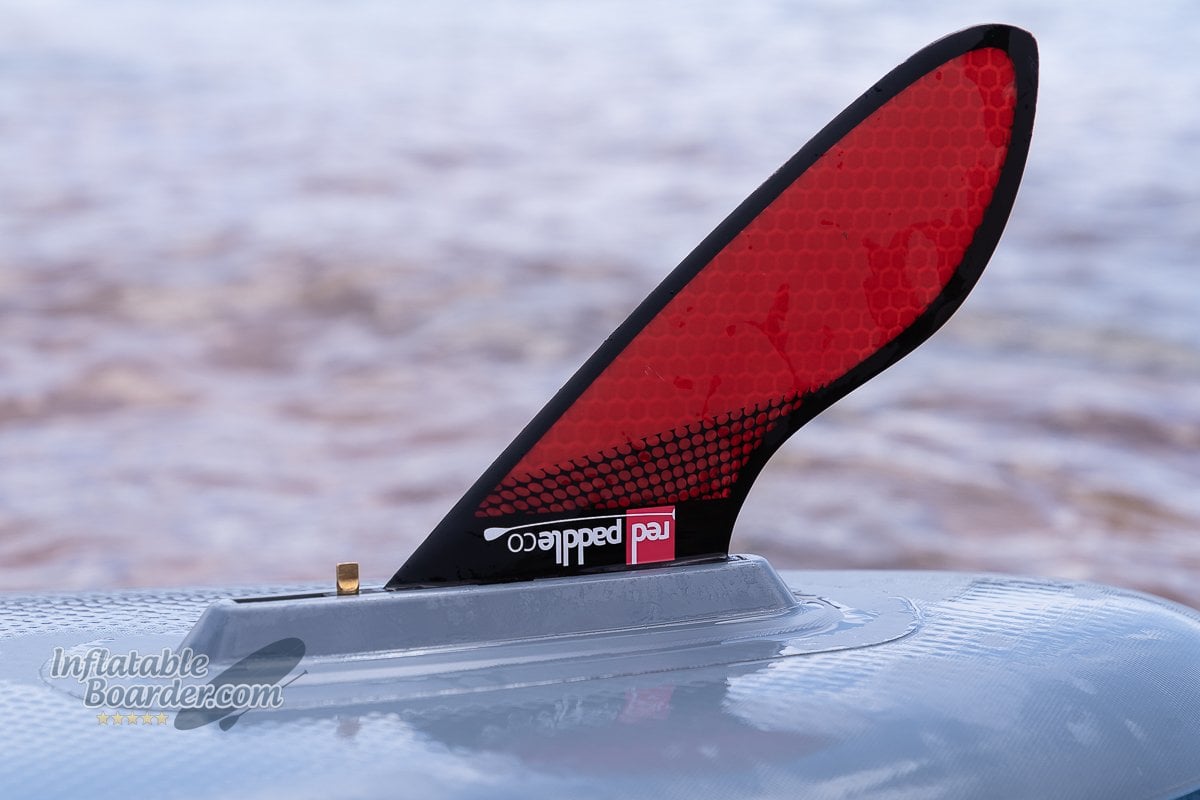
The fiberglass race fin expertly balances speed and tracking.
The 12’6” Elite includes Red Paddle Co.’s fiberglass race fin which gives just the right balance of speed, stability and tracking to this package. The swept back design sheds any weeds/vegetation you may paddle through and increases the overall tracking performance without creating too much drag. The honeycomb fiberglass construction resists flexing when under pressure, keeping the board tracking straight, even in rough conditions.
I had no issues staying on course while paddling and the 12’6” Elite needed very little steering input to keep going straight. At the same time it did not over-correct my steering, so when I did want to adjust course or turn, it only took a few strokes to do so.
Warranty and Customer Support
Red Paddle Co. includes a 1 year warranty as soon as you purchase your board and extends it to a 5 year warranty (at no cost) once you register your product on their website. Registration must be done within 3 months of purchase, so make sure to get on there and register your warranty. Red Paddle Co. offers a 30 day return period for new/unused items. Red Paddle Co. also sells products through a retailer network – so individual retailers may have additional or different return policies.
You can reach Red Paddle Co. for questions or warranty claims through their website, email, phone, and social media.
Value
Red Paddle Co. has long been one of the top names in the iSUP industry. They push the boundaries of materials and designs, develop new materials and processes, and create very high-quality products with an excellent warranty. This all does come with an associated price tag, and because Red Paddle Co. is also a retail brand (in addition to offering direct-to-consumer sales) part of that price does include what is called MAP (Minimum Advertised Price) that helps protect retailers’ margins. The quality of Red Paddle Co. products is undisputed, however the price tag is high. For a beginner or casual intermediate paddler that may not be the best value for their dollar, but for the true enthusiast and advanced riders that price is very often worth it.
Overall Impressions/Review Summary
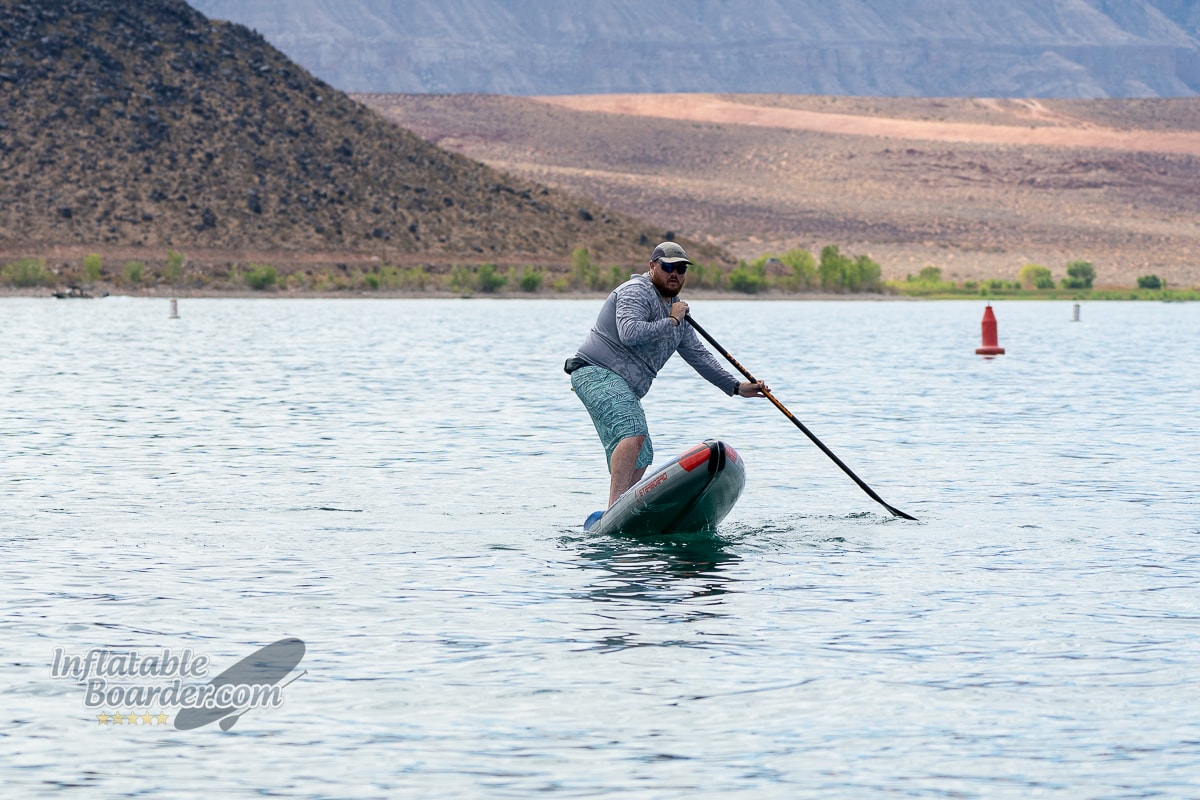
The 12’6” Elite is a versatile board for those who want to go fast.
The Red Paddle Co. 12’6” Elite offers a little bit of everything to the paddler who likes to go fast or go far (or both). It’s got enough stability and volume for some light-duty touring, it’s a fantastic fitness SUP for those looking to get a great workout on the water, and it’s fast enough to compete in all but the highest-caliber races around the world. I feel that the 12’6” Elite is a Jack of All Trades. It’s a really good option for doing multiple things, but not necessarily the best option for any one of them. For the advanced paddler looking for a race board, I would recommend looking at narrower and/or longer boards like the 14’ Elite or the Starboard All Star Airline for a faster ride overall, and those who are more interested in overnight touring may want to consider models like the 13’2” Voyager or 12’6” Sport with their extra width and stability.
It’s important to remember the last line of the phrase though: the Jack of all trades is master of none, still better than master of one. If you are an intermediate or advanced paddler looking for a board that is fast, efficient, fun to paddle, and offers some versatility in how you use it, then the Red Paddle Co. 12’6” Elite is the right choice for you.
Red Paddle Co. 12’6” Elite MSL iSUP FAQ
What is MSL construction?
MSL (Monocoque Structural Laminate) is the trade name for Red Paddle Co.’s material and construction process where a single, thick, layer of reinforced PVC is glued and heat-laminated to a woven drop stitch fabric. This produces a durable, stiff, and lightweight material that is then built into a high-quality iSUP.
What are the RSS battens and FFC rod?
The RSS (Rocker Stiffening System) battens and FFC (Forward Flex Control) rod are removable, exterior elements designed to stiffen critical areas of the 12’6” Elite and other Red Paddle Co. iSUPs. The RSS battens are placed into special sleeves on the rail of the board on either side of the standing area, and the FFC rod is placed into an anchor system on the front third of the deck. These systems prevent excess flex while paddling or in choppy conditions.
What is the nose fin on the Red Paddle Co. 12’6” Elite? Is it the same as a V-hull?
The nose fin on the 12’6” Elite is not a fin designed to help the board track straighter, but rather a small plastic fin adhered under the nose of the board and designed to break the surface tension of the water where it meets the board and increase the gliding efficiency of the iSUP. The nose fin is not the same as a V-hull. A V-hull completely changes the interior and exterior construction of the paddleboard to produce a rounded shape on the hull of the board.
Is the Red Paddle Co. 12’6” Elite good for racing or touring?
The 12’6” Elite is designed for racing. It can be used as a light-duty touring board, however the narrower width, strongly tapered outline, and lack of built in cargo space do not make ideal for overnight trips.
Is the Red Paddle Co. 12’6” Elite beginner friendly?
The 12’6” Elite is a great option for paddlers who already know at least the basics of stand up paddleboarding and are looking for a board that can be used for racing or to advance their skills. True beginners will find the Red Paddle Co. 12’6” Elite very difficult to use.
Is the Red Paddle Co. 12’6” Elite worth the cost?
If you are looking for a high-quality inflatable race board and want the latest-and-greatest technology available in inflatable paddleboarding, then the 12’6” Elite is worth the cost. If you are a beginner, or not necessarily interested in racing, you may not find the same value proposition in the 12’6” Elite.







Leave a Reply